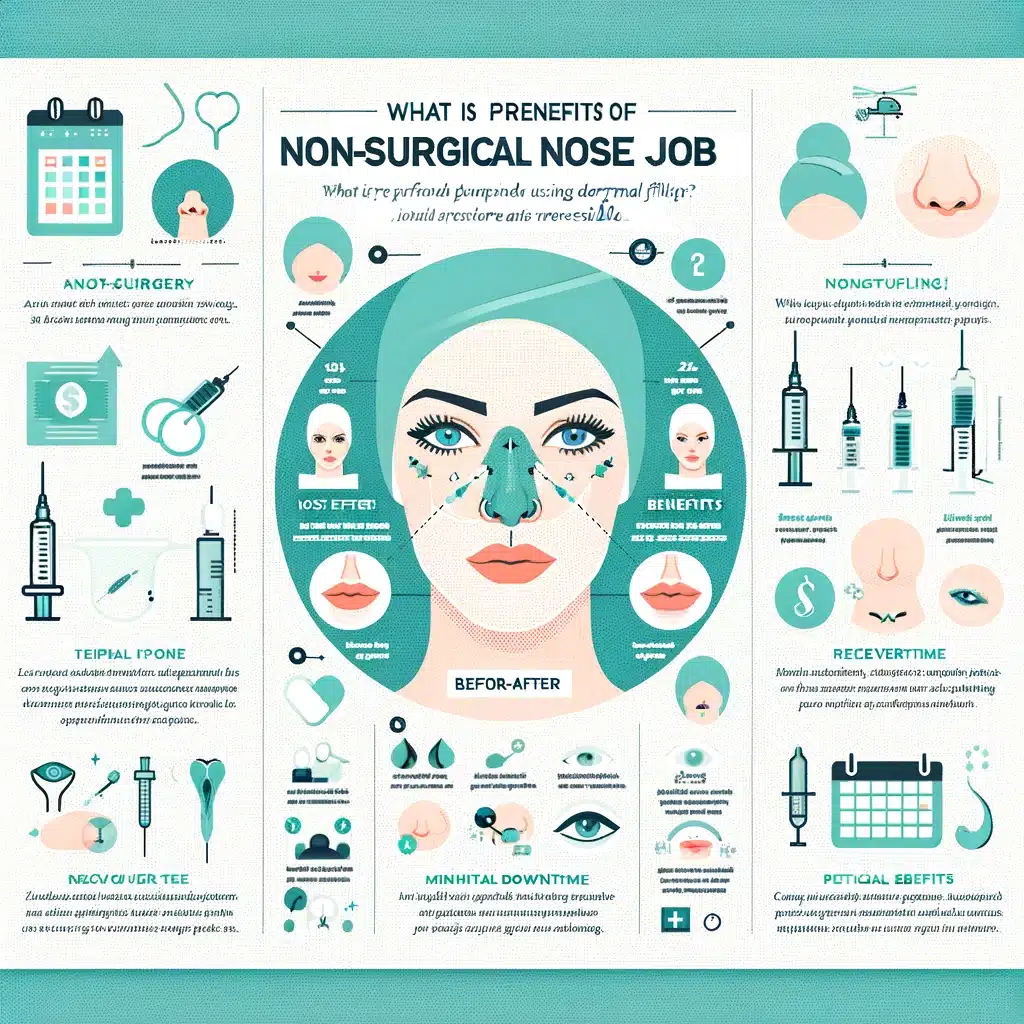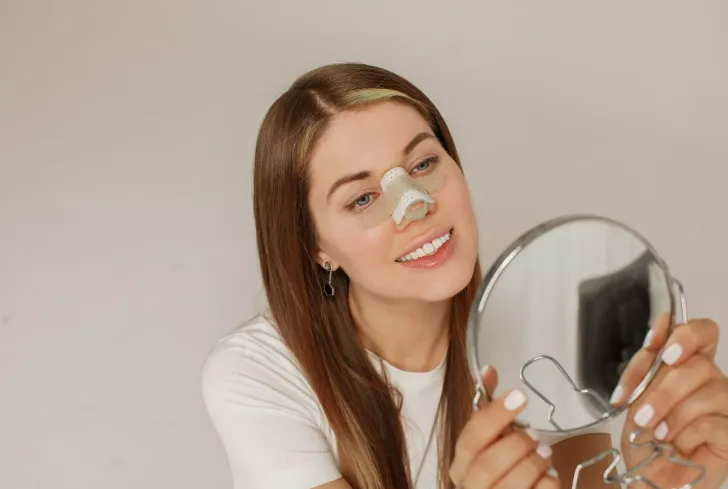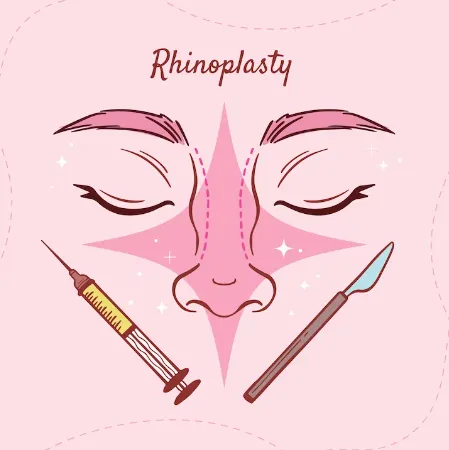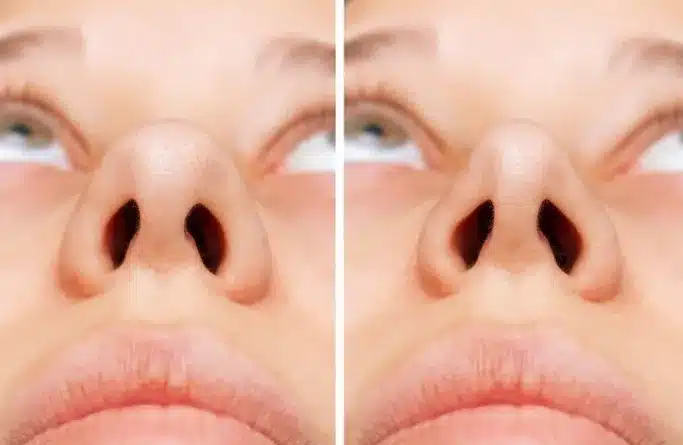Welcome to the realm of non-surgical nose jobs, where transformative enhancements are achieved through the artful application of dermal fillers. This innovative approach to nasal augmentation offers a non-invasive alternative to traditional rhinoplasty, utilizing injectable techniques to sculpt and refine the contours of the nose. With injectable rhinoplasty, individuals can achieve subtle yet significant changes in nasal appearance without the need for surgery, heralding a new era in cosmetic procedures.
Different Types of Non-surgical nose jobs
While surgical rhinoplasty has long been the primary option for altering the nasal structure, advancements in medical aesthetics have led to the emergence of non-surgical alternatives. This article will explore the world of “non-surgical nose jobs,” exploring the various types, benefits, risks, and suitability for different age groups.
The nose plays a significant role in defining our facial features, and for many individuals, its shape or size may cause self-consciousness or dissatisfaction. Fortunately, advancements in cosmetic surgery have made it possible to alter the appearance of the nose through rhinoplasty, commonly known as a “nose job.”
Nose jobs without surgery, often called non-surgical rhinoplasty or liquid rhinoplasty, encompass a range of cosmetic procedures to alter the nose’s appearance without surgical intervention. These procedures utilize injectable fillers, typically hyaluronic acid-based, to reshape and refine the nasal contours.
The primary types of non-surgical nose jobs include:
- Dorsal Hump Reduction: This procedure focuses on correcting a prominent bump on the bridge of the nose, creating a smoother profile.
- Tip Refinement involves reshaping and lifting the nasal tip, providing a more defined and aesthetically pleasing look.
- Nasal Symmetry: Non-surgical techniques can address asymmetry issues, creating a more balanced appearance.
- Correction of Minor Irregularities: Non-surgical methods can correct minor imperfections such as depressions or irregularities on the nose’s surface.
Clinic contact number: +989371200167
Comparing Non-surgical Nose Jobs with Rhinoplasty
While both non-surgical nose jobs and surgical rhinoplasty aim to enhance the nose’s appearance, they differ significantly in approach, invasiveness, and permanence.
In the realm of imagination and creativity, a fantasy nose job allows individuals to transform their appearance in extraordinary and unique ways. Whether inspired by mythical creatures, fantastical characters, or personal artistic visions, a fantasy nose job allows one to explore the realms of imagination and bring dreams to life.
- Approach: Non-surgical procedures involve the precise injection of fillers, while surgical rhinoplasty requires incisions and manipulation of nasal tissues.
- Invasiveness: Non-surgical options are minimally invasive, causing less tissue trauma and shorter recovery than surgical rhinoplasty.
- Permanence: Non-surgical results are temporary, typically lasting 6 to 18 months, depending on the filler used. Surgical rhinoplasty results are generally permanent.
- Complexity: Surgical rhinoplasty is suitable for more significant changes to the nasal structure, while non-surgical options are better suited for minor corrections and enhancements.
Which Age Can Get Non-Surgical Nose Jobs?
Non-surgical nose jobs are an appealing option for various age groups. Younger individuals are hesitant about undergoing surgery or want to test the waters before committing to permanent changes often find non-surgical options attractive. Additionally, older individuals who desire subtle improvements without the lengthy downtime associated with surgery also benefit from non-surgical alternatives.
It’s important to note that the suitability for any cosmetic procedure, including non-surgical nose jobs, depends on individual factors such as skin type, nasal anatomy, and overall health. Consulting with a qualified medical professional is crucial to determine the most appropriate action.

Can nonsurgical rhinoplasty do what surgery does?
Nonsurgical rhinoplasty, also known as a liquid or non-invasive rhinoplasty, can achieve certain cosmetic enhancements to the nose, but it does have limitations compared to surgical rhinoplasty. While nonsurgical rhinoplasty can address minor imperfections and asymmetries of the nose, such as bumps on the bridge, a drooping nasal tip, or minor deviations, it cannot achieve the same level of structural changes or functional improvements as surgical rhinoplasty. Surgical rhinoplasty allows for more extensive modifications to the nasal structure, including reshaping the nasal bones and cartilage, reducing or augmenting nasal size, and correcting breathing difficulties or nasal obstruction.
Rhinoplasty, while often pursued for aesthetic enhancement, entails inherent risks that extend beyond mere cosmetic concerns. Nasal surgery, synonymous with rhinoplasty, presents potential complications such as septal perforation and nasal valve collapse, which can significantly impact both function and appearance. Understanding these risks is paramount for individuals considering or undergoing rhinoplasty, as they underscore the importance of thorough preoperative assessment and skilled surgical intervention.
Additionally, the results of nonsurgical rhinoplasty are temporary and typically last for several months to a year, depending on the type of filler used and individual factors. In contrast, surgical rhinoplasty offers permanent results, as the structural changes made to the nose are permanent and do not rely on injectable fillers to maintain their shape. While nonsurgical rhinoplasty may be a suitable option for individuals seeking minor cosmetic enhancements to the nose without surgery, those with more complex nasal concerns or functional issues may require surgical intervention to achieve their desired outcome.
Ultimately, the decision between nonsurgical and surgical rhinoplasty depends on the individual’s specific concerns, aesthetic goals, and preferences. Consulting with a qualified facial plastic surgeon or dermatologist can help determine the most appropriate treatment approach based on the patient’s unique anatomy, expectations, and desired outcome. They can provide personalized recommendations and discuss the pros and cons of each option to help the patient make an informed decision regarding their nasal enhancement procedure.
Clinic contact number: +989371200167
risk of non-surgical nose jobs

Liquid nose jobs
10 years ago, only the brave went under the knife for rhinoplasty. Now, non-surgical ‘liquid nose jobs’ are booming with their promise of a straighter, more defined nose with next-to-no downtime and at a fraction of the cost.
The first liquid nose job, using ‘liquid’ dermal fillers, was documented in 2006 – but proof of its popularity today are the numerous intriguing videos of the procedure currently going viral on TikTok.
Perhaps the social platform’s obsession with the liquid nose job isn’t so surprising: nose jobs, both surgical and non-surgical, continue to be one of the most-performed surgeries globally. In its 2022 annual audit, the British Association of Aesthetic Plastic Surgeons (BAAPS) estimated that rhinoplasty was one of the top UK cosmetic surgery procedures, with over 2,220 cases performed in 2022, an increase of 67% over the year before.
According to the pros, many patients continue to cite ‘zoom-face’ as one of their motivations for booking since the pandemic – with the ‘dorsal hump’ (a bump on the nose made from cartilage and bone) as the main area of concern. Whatever the reason, it’s your face and your choice. Our main aim at GLAMOUR is to ensure you have all the information you need before booking any procedures.
Benefits of a non-surgical nose jobs
- Minimally Invasive: Non-surgical procedures avoid incisions and tissue manipulation, resulting in minimal trauma and reduced risk of complications.
- Quick Results: Non-surgical nose jobs offer immediate results, with minimal to no downtime required for recovery.
Exploring the different Types of Non-surgical nose jobs reveals the potential Benefits of a Non-surgical nose job. - Temporary Nature: The temporary nature of fillers allows individuals to experiment with changes before committing to permanent alterations.
- No General Anesthesia: Non-surgical options do not require general anesthesia, minimizing associated risks.
- Subtle Enhancements: Non-surgical procedures excel at creating subtle changes, maintaining the natural look of the face.
- Reversible: If the desired outcome is not achieved, the procedure can be reversed or adjusted with additional injections or dissolving agents.
- Cost-Effective: Non-surgical procedures generally cost less than surgical rhinoplasty, making them more accessible to a broader range of people.
- Minimal Downtime: Individuals can resume their daily activities almost immediately after the procedure, unlike surgical rhinoplasty, which requires a more extended recovery period.
- Painless Procedure: Non-surgical nose jobs are typically performed with local anesthesia or numbing cream, ensuring minimal discomfort.
- Customizable: The precise injection techniques allow tailored adjustments to meet each individual’s unique aesthetic goals.
After liquid rhinoplasty with non surgical nose job industry, you may see pain, swelling, and redness where your injection was inserted. Health Line
Non-Surgical Solutions for Nasal Enhancement
In recent years, non-surgical nose jobs have garnered significant attention within the realm of aesthetic medicine. Renowned institutions such as Harvard Medical School and Stanford University have conducted pioneering research in this domain, elucidating novel techniques and safety protocols. Dr. Alexander Rivkin, a prominent figure in the field, has contributed extensively to the advancement of non-surgical rhinoplasty methodologies, championing the use of dermal fillers for subtle yet transformative nasal reshaping.
With the advent of advanced imaging technologies and precise injection methods, these academic leaders have elevated non-surgical nose jobs to a sophisticated art form, blending medical expertise with artistic finesse. Leading the charge in non-surgical nasal enhancements is the esteemed clinic, Beverly Hills Aesthetics. Renowned for its cutting-edge procedures and commitment to patient satisfaction, this institution has emerged as a beacon of innovation in the field of non-surgical rhinoplasty.
Their team of skilled practitioners, equipped with state-of-the-art equipment and unparalleled expertise, has propelled the acceptance and adoption of non-invasive nasal augmentation techniques. Recent statistics indicate a substantial surge in the demand for non-surgical nose jobs, with a staggering 30% increase in procedures performed annually. This surge underscores the growing popularity of minimally invasive alternatives to traditional rhinoplasty, emphasizing safety, efficacy, and rapid recovery.

Risks of non-surgical nose jobs
Non-surgical nose jobs, also known as liquid rhinoplasty or filler rhinoplasty, involve the injection of dermal fillers into the nose to alter its shape. This procedure can temporarily modify the appearance of the nose without the need for invasive surgery. While it offers several benefits, including minimal downtime and immediate results, there are several risks and potential complications to consider:
Vascular Complications
One of the most serious risks is the accidental injection of filler into a blood vessel, which can lead to blockage of the blood flow. This can result in skin necrosis (death of skin tissue), vision abnormalities, or even blindness if the filler blocks a vessel that supplies blood to the eyes.
Infection
As with any procedure that involves breaking the skin barrier, there is a risk of infection. This can range from minor skin infections to more serious conditions that may require medical treatment.
Allergic Reactions
Some individuals may have allergic reactions to the filler material. Symptoms can include redness, itching, swelling, and in severe cases, anaphylaxis, which is a potentially life-threatening condition.
Asymmetry
Improper injection technique or uneven filler distribution can lead to asymmetry, making the nose appear uneven or unbalanced.
Overcorrection or Under correction
Achieving the desired result can be challenging, and there is a risk of either too much or too little correction. This may necessitate additional procedures to adjust the outcome.
Skin Irregularities
The skin on the nose may appear bumpy or uneven if the filler is not injected smoothly or if it clumps together.
Improper Injection Technique
One of the primary causes of skin irregularities is the improper placement of the filler. If the filler is injected too superficially or unevenly distributed, it can lead to visible lumps or bumps.
Type of Filler Used
Some fillers are thicker and may not be as well-suited for areas with thinner skin, like the nose. The choice of filler material can significantly impact the smoothness of the result.
Overcorrection
Injecting too much filler can lead to an unnatural appearance, with the skin stretched too tightly over the filler material, resulting in bumps and lumps.
Body’s Reaction to Filler
Sometimes, the body’s response to the filler material can contribute to irregularities. For example, inflammation or granuloma formation (a type of inflammatory reaction) can cause bumps.
Prolonged Swelling or Bruising
While some swelling and bruising are normal, in some cases, these conditions can persist longer than expected, affecting the appearance of the nose for an extended period.
Limited Results and Longevity
The results of non-surgical nose jobs are temporary, typically lasting between 6 to 18 months. This means repeated procedures are necessary to maintain the desired effect, increasing the cumulative risk of complications over time.
It’s crucial to consult with a qualified and experienced healthcare professional to discuss these risks and to determine whether a non-surgical nose job is the right option for you. They can provide a thorough assessment and tailor the procedure to minimize risks while aiming for the best possible outcome.

Summary
Non-surgical nose jobs offer a compelling alternative to traditional surgical rhinoplasty, allowing individuals to enhance their nasal aesthetics without requiring invasive procedures. These procedures are minimally invasive, quick, and offer temporary yet customizable results. In conclusion, non-surgical nose jobs represent a revolutionary approach to aesthetic enhancement, leveraging the versatility of dermal fillers to achieve remarkable results in nasal augmentation.
Through non-invasive techniques, individuals can undergo nasal dorsum correction and achieve desired nasal reshaping without the risks and recovery associated with traditional surgical procedures. The popularity of nose filler injections continues to soar as more people seek subtle yet impactful changes in their nasal appearance, heralding a paradigm shift in cosmetic interventions towards less invasive options. With non-surgical nose jobs, individuals can attain harmonious facial proportions and enhanced self-confidence, marking a transformative evolution in the field of aesthetic medicine.
Clinic contact number: +989371200167
FAQs
1. What is a non-surgical nose job?
– A non-surgical nose job, also known as non-surgical rhinoplasty or liquid rhinoplasty, is a cosmetic procedure that involves using injectable fillers to reshape and enhance the appearance of the nose without surgery. Dermal fillers, typically made of hyaluronic acid, are strategically injected into specific areas of the nose to correct minor imperfections, such as bumps, asymmetry, or depressions, and to improve overall nasal symmetry and balance.
2. What are the advantages of a non-surgical nose job compared to traditional rhinoplasty?
– Non-surgical nose jobs offer several advantages over traditional rhinoplasty, including minimal downtime, quick results, and no need for general anesthesia or surgical incisions. Since the procedure is performed using injectable fillers, there is no surgical recovery period, and most patients can resume normal activities immediately after the treatment. Additionally, non-surgical nose jobs are less invasive and generally involve fewer risks and complications compared to surgical rhinoplasty, making them an attractive option for individuals seeking minor cosmetic enhancements to the nose.
3. What can a non-surgical nose job address?
– Non-surgical nose jobs are best suited for individuals with minor aesthetic concerns or imperfections of the nose, such as bumps on the bridge, asymmetry, or a drooping nasal tip. The procedure can help improve nasal symmetry, create smoother contours, and enhance overall nasal appearance without altering the underlying nasal structure. However, it’s important to note that non-surgical nose jobs are not suitable for correcting functional issues, such as breathing difficulties or nasal obstruction, which may require surgical intervention.
4. How long do the results of a non-surgical nose job last?
– The results of a non-surgical nose job are temporary and typically last for several months to a year, depending on the type of filler used and individual factors such as metabolism and lifestyle. Over time, the body gradually metabolizes the filler, causing the treated areas to gradually return to their pre-treatment state. To maintain the results of a non-surgical nose job, periodic touch-up treatments may be required, typically every 6 to 12 months, to preserve the desired nasal shape and appearance.
5. Are there any risks or side effects associated with a non-surgical nose job?
– While non-surgical nose jobs are generally considered safe, there are potential risks and side effects associated with the procedure, including temporary swelling, bruising, redness, or tenderness at the injection sites. In rare cases, more serious complications such as infection, allergic reactions, or vascular compromise may occur. It’s essential to choose a qualified and experienced provider for non-surgical nose jobs and to carefully follow post-treatment instructions to minimize the risk of complications and achieve optimal results.
Nonsurgical Rhinoplasty: What to Expect, Cost, Recovery, and More (healthline.com)
https://www.glamourmagazine.co.uk/article/non-surgical-nose-job-review




